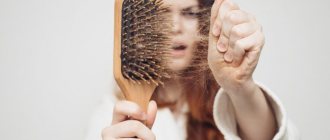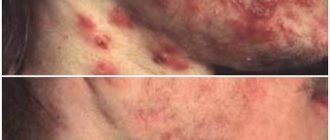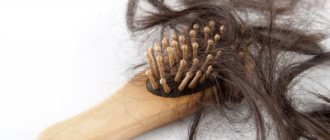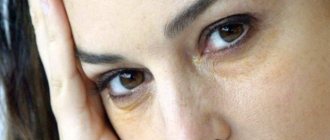Causes and trigger factors of diffuse telogen effluvium
1. Malnutrition (starvation)
a. Protein-calorie malnutrition (kwashiorkor, cachexia)
b. Zinc deficiency
c. Iron deficiency
e. Deficiency of essential fatty acids during parenteral nutrition
2. Dysfunction of the endocrine system
a. Hypothyroidism
b. Hypoparathyroidism
c. Panhypopituitarism
e. Cancellation of hormonal contraceptives
3. Exogenous and endogenous intoxications
a. Intoxication with drugs and chemicals
4. Stress
Iron deficiency
The recommended daily dose is 14 mg of iron per day. However, 93% of women of reproductive age receive a much lower dose through food, leading to the following statistics: 700,000,000 people suffer from iron deficiency anemia.
Latent iron deficiency is also common among the population, in which the hemoglobin level remains normal, but the tissue and transport stores of iron are already depleted. This situation resolves on its own in only 13% of women. About 26% develop the manifest form of deficiency anemia.
Zinc deficiency
There are congenital and acquired zinc deficiency.
- Congenital (enteropathic acrodermatitis) is a hereditary disease associated with impaired absorption of zinc on the bristles of the intestinal rim.
- Acquired zinc deficiency is usually the result of decreased dietary zinc intake: parenteral nutrition;
- with Crohn's disease;
- with increased catabolism, which occurs during injuries, burns, and operations.
In addition to intense hair loss, we can observe characteristic skin changes, as well as changes in nails (Bo's lines and paronychia).
Bo's lines are transverse depressions or grooves up to 1 mm deep. Some researchers have found a positive relationship between the level of zinc deficiency and the depth of indentation on the nails.
Paronychia is an inflammation of the periungual fold.
| Bo Lines | Paronychia |
Researchers distinguish primary, secondary, tertiary and peripheral hypothyroidism.
Postpartum alopecia occurs 2-3 months after birth. It is observed due to a decrease in estrogen levels.
The condition is characterized by the fact that during pregnancy, under the influence of estrogens, the growth phase is lengthened and hair growth is synchronized. After estrogen levels decrease, hair follicles (up to 60%) synchronously enter the shedding phase, which causes intense hair loss.
Estrogens prolong the anagen phase and affect the length of the hair growth cycle. After discontinuation of contraceptives, a huge number of hair follicles enter the telogen phase, which leads to intense hair loss.
Diffuse telogen effluvium caused by drugs develops 9-12 weeks after the start of drug use. Hair loss occurs throughout the entire period of taking the medicine.
Typical loss is no more than 150 hairs per day. However, when taking interferon and cytostatics, hair loss up to 300 per day is typical.
- Retinoids affect the processes of keratinization in the hair follicle
- Vitamin A ({amp}gt;50,000 IU per day)
- Acitretin
- Etretinate
- Isotretinoin
- Interferon has a cytokine-like effect
- Alpha interferon
- Interferon gamma
. affect thyroid metabolism
- Propylthiouracil
- Levothyroxine
- Carbimazole
- Amiodarone (antiarrhythmic effect)
- Anticoagulants: affect blood flow in the follicular papilla
- ACE inhibitors bind zinc
- Captopril
- Enalapril
- Lisinopril
- Losartan
- Ramipril
- Lipid-lowering drugs affect cholesterol synthesis
- Fibrates (Clofibrate, Bezafibrate, Fenofibrate, Gemfibrozil)
- Lovastatin
- Atorvastatin
- Triparanol
- Cholestyramine
- Androgens, anabolics - androgenic effect
- Mesterolone
- Testosterone
- Danazol
- Antiestrogens: reduce estrogen levels
Its involvement in stess-induced telogen effluvium has been proven. Under the influence of SP, histamine, TNF-a, TGF-b, NGF (I'm not sure about this), etc. are released, leading to intense hair loss.
b. Zinc deficiency
c. Iron deficiency
a. Hypothyroidism
b. Hypoparathyroidism
4. Stress
How it develops and progresses
Each hair growth goes through three developmental phases:
- anagen;
- catagen;
- telogen.
At the first stage, hair undergoes a process of maturation and pigmentation. This phase can take from 2 to 7 years. The second lasts only two weeks, during which the mature hair moves from the follicle to the skin layer.
During the telogen phase, the new one pushes out the old one. Hair falls out and is replaced. The duration of this period is up to 3 months.
During the disease process, the catogen phase is completely absent. It turns out that new hair has not formed, and the old one has already fallen out.
Causes
The main factors that provoke disruption of normal hair growth and the onset of diffuse alopecia:
- Transmission of infectious diseases. Among the most common diseases that can provoke diffuse alopecia are pneumonia, typhoid fever, influenza, malaria, syphilis, infectious mononucleosis, bruzcelosis, tuberculosis, and HIV. Long-term recurrent fevers are fraught with the onset of diffuse baldness after an average of 2 months.
- Chronic diseases. Most often, diffuse baldness occurs due to dysfunction of the endocrine system - with hyperthyroidism and hypothyroidism. Other chronic diseases that provoke diffuse alopecia include psoriasis, lupus erythematosus, and erythroderma.
- Taking medications. Diffuse alopecia can develop due to long-term use of the following groups of medications: antiparkinsonian drugs, beta-blockers, retinoids, cytostatics, anticoagulants, anticonvulsants, H2-receptor blockers. A high dosage and long-term use of one of these drugs can provoke anogenetic alopecia, a low dosage with long-term use can cause telogen effluvium.
- Psychosomatic factors. Diffuse alopecia is often caused by severe stress and other psycho-emotional disorders.
- Deficiency of nutrients in the body. Deficiency of iron, selenium, chromium, zinc and vitamin B12 can lead to diffuse alopecia. In addition, hair loss can begin against the background of protein-calorie deficiency.
According to studies, in children suffering from diffuse alopecia, in one hundred percent of observed cases, the body had a deficiency of selenium and a pronounced imbalance of manganese, copper, zinc, iron and potassium.
Diagnostics
To determine the causes of the pathology and prescribe subsequent treatment, you need to contact a trichologist. After the examination, the doctor may refer you for a consultation to specialists - an endocrinologist, gastroenterologist, neurologist, allergist. It is required to undergo a comprehensive diagnosis to choose treatment tactics.
Examination for baldness:
- A general and biochemical blood test is the first stage of diagnosis. Allows you to determine the presence of inflammatory processes by analyzing the main indicators and immune status.
- Hormonal markers help to identify dysfunction of the thyroid gland, adrenal glands, and determine the level of dihydrotestosterone.
- A sugar test or glucotest can detect diabetes.
- Allergy tests are prescribed to isolate toxins, as well as to exclude pathological conditions accompanied by baldness.
- Ultrasound of internal organs, in particular the thyroid gland, abdominal cavity and genitourinary system, is performed to exclude inflammatory processes.
- Tests for helminths - parasites can cause metabolic disorders, decreased immunity, intoxication and the development of an allergic reaction.
- If immunodeficiency is suspected, an immunogram is prescribed.
The most effective shampoos for hair loss
To achieve maximum effect in the treatment of baldness, when selecting shampoo, you need to focus on the type and characteristics of this disease.
Diffuse alopecia can be caused by stressful conditions, sudden changes in climatic conditions, increased mental stress, chronic diseases, infectious processes, sudden weight loss, insomnia, anemia, and childbirth.
In this case, shampoos containing tea tree and poppy oils, burdock extract, betaine, arginine, niacinamide, and B vitamins can help.
For diffuse type alopecia
To combat diffuse type alopecia, the following shampoos are ideal:
- Burdock shampoo
Shampoo containing burdock extract and burdock oil is one of the most popular and affordable. Its action is aimed at strengthening the shaft of each hair.
Tar shampoo
Tar shampoo with additives in the form of extracts of medicinal plants or propolis. As a result of using this product, hair becomes stronger, thicker and stronger.
L'OREAL Elseve "The Power of Arginine"
This is a shampoo that, in addition to the main component (arginine), contains wheat proteins, salicylic acid and betaine. Its use promotes effective hair restoration at the cuticle level.
In the treatment of androgenetic alopecia
The cause of androgenetic alopecia is the high sensitivity of hair follicles to the hormone testosterone.
Read more about the relationship between hormones and hair loss here. Shampoos containing plant extracts of mint, ginseng, nasturtium, camellia and dwarf palm fruit, as well as copper peptides and ketoconazole, have a significant effect.
Treatment will be effective when using the following shampoos:
- Tricomin
Shampoo based on copper peptides, which is an ideal treatment for androgenetic and diffuse baldness.
The results of its use are a significant decrease in the sensitivity of the follicles to dihydrotestosterone and their complete restoration. Shampoos against baldness from the Trikomin series are contraindicated for women during pregnancy and breastfeeding.
Nizoral
Another highly effective remedy is Nizoral shampoo based on ketoconazole. The maximum effect in men can be achieved through its use in combination with drugs such as finasteride and minoxidil.
With focal type of disease
The most common type of baldness is focal type. In this case, complex treatment is prescribed, and shampoos play the role of auxiliary agents.
For alopecia areata, it is recommended to use the following products:
- Progain
Shampoo based on protein and wheat amino acids is characterized by excellent cleansing properties. By providing the hair follicles with adequate nutrition, this drug gradually restores the correct growth cycle.
Cavill
Cavill shampoos, produced by the famous Italian company Discos, are also effective; they must be selected depending on your hair type. The option for normal hair and hair prone to dryness contains almond, coconut and castor oils, as well as horsetail plant extract and acacia honey.
The shampoo for oily and combination hair includes coconut and castor oils, sage, birch and rosemary extracts, nettle juice and zinc oxide.
Read the following useful articles on the treatment of alopecia on our website:
- the best folk remedies for baldness: the effectiveness of this treatment method;
- the best recipes for masks against baldness at home;
- Is it possible to cure androgenetic alopecia, how to do it and what methods are the most effective?
- modern methods of hair transplantation, including non-surgical techniques and the price of the procedure.
How is medication treated?
Treatment with medications is mandatory at the stage of eliminating the root cause of the disease. Depending on the disease that provoked diffuse alopecia, the doctor selects a specific course of treatment.
After getting rid of the root cause, the following drug therapy is prescribed, which includes:
- a complex of vitamins and microelements (B, zinc, copper, iron);
- photosensitizers - lead to an increase in the level of ultraviolet susceptibility, which affects hair growth. This option is effective even with severe baldness;
- copper peptides to strengthen remaining hair (Tricomin with Foligen).
Other causes of hair loss
Often, baldness in women is not associated with any disease, but occurs for some other reason. Environment. Moving to a place with a new climate or too sudden a change in weather - all this can lead to hair loss in women. Thermal damage to hair. Baldness may be associated with the constant use of hair dryers, curling irons, straightening irons, etc. Due to prolonged exposure to high temperatures on the hair, it begins to break, become thinner and fall out. Dreadlocks, tight ponytails, African braids. Due to the tight grip of the strands, these hairstyles mechanically damage the hair structure. A large amount of hair falls out during the process of creating a hairstyle. Hair loss begins due to the fact that the hair ceases to be “alive.” In addition, their nutrition and blood microcirculation in the hair follicles are disrupted. Trauma and head damage. Hair growth may stop at the site of severe wounds. Use of birth control pills. Such medications directly affect the balance of hormones in a woman’s body and can cause baldness. To prevent this from happening, the selection of contraceptives should be carried out together with the attending gynecologist. Improper hair care. A woman who washes her hair very often or, conversely, very rarely, may experience hair loss. Hair should be washed 2-3 times a week, using high-quality shampoo and conditioner. You need to rinse your curls with a decoction of herbs. You should also periodically make homemade nourishing masks.
Classification and localization
Diffuse alopecia is divided into two types according to the nature of its manifestation:
- Telogen.
- Anagen.
With telogen effluvium, hair falls out rapidly at certain moments when the follicle stops growing and enters the resting stage (telogen). The hairs become detached from their follicles and fall out. This type of disease goes through several stages of development:
- The reason for the appearance of the first stage is the impact of external and internal negative influences. The bulbs, without passing through the growth stage, move on to the next one, as a result of which a huge number of hairs fall out.
- The second stage occurs after intensive hair growth (anagen stage). It occurs in women after the birth of a child, when the mother begins to intensively lose her hair. The reason for this is a hormonal imbalance during pregnancy, when the bulbs do not enter the resting phase from active growth, but immediately enter it after childbirth.
- A short stage of growth when hair cannot be grown back because it is very brittle.
- The resting stage, which completes the growth stage.
- Late completion of the rest period. Typical for populations living where the day length is very short.
Telogen diffuse alopecia
During telogen effluvium, the process of loss is long, from one month to a year, and lasts until the cause of this pathology is eliminated. If left untreated, the disease becomes chronic and results in complete baldness.
Anagen effluvium alopecia is characterized by sudden baldness over the entire scalp. Appears after taking potent medications, radiation exposure and excessive amounts of retinol in the body. As a result of all these factors, hairs become thinner and stop growing. First, hair falls out, which passes from active growth into a period of rest, and later, in the resting stage, the rest falls out.
How to cure chronic anagen diffuse alopecia?
There is also chronic anagen diffuse hair loss, which consists of periodic baldness, approximately twice a year, when diffuse hair loss is most active. However, after some time, the hairline is able to recover on its own.
Diffuse alopecia has no cure. No folk methods or expensive shampoos will get rid of this disease. This will only provoke more intensive growth of new hair. It will go away only after the cause of its occurrence is eliminated. As a rule, diagnosis begins with a blood test and trichogram.
In addition, it would be good to undergo examination by an endocrinologist, andrologist and gynecologist (urologist). Once the cause of this type of alopecia is known, an appropriate course of treatment is prescribed.
Trichologist
How effective is treatment with folk remedies?
For partial hair loss, treatment is selected in a comprehensive manner. Among traditional medicine methods, a mixture of red pepper and vodka is effective. One hot pepper requires 100 grams of vodka. The solution is infused for a day and rubbed into bald areas. Suitable for both men and women.
The onion, ground into a paste, is rubbed into the scalp. Irritation from onions causes blood flow and growth stimulation. In case of intense hair loss, burdock oil is used - it strengthens hair and stimulates new growth.
Mix a couple of tablespoons of mustard powder with vegetable oil. Apply the mixture to the roots, leave for half an hour or until it starts to burn.
Folk remedies are effective for hair loss, but only if the root cause of the disease is eliminated.
Qualification
Member of the International Society of Hair Transplantation and Restoration ISHRS, USA, member of the Russian Society of Trichologists and full member of the Society of European Doctors, member of FUE EUrope. More than 17 years of experience in hair transplantation using the latest techniques in Russia and foreign clinics.
Graduate of DonMI, 1992. Internship in dermatovenerology. Since 1998, he has been working on hair transplantation in clinics in Greece, Italy, France, Portugal, and Serbia. In 2004, he mastered a new completely non-surgical method of FUE/FUI hair transplantation and began collaborating with the DHI company. Since 2008, he has been working in Ireland and England, using a more advanced method of non-surgical hair transplantation, H+. After studying in Russia for advanced training courses, Schneider becomes a member of the Russian Society of Trichologists. Since 2009-2010, he has been introducing in Russia an improved method of non-surgical hair transplantation based on H+, which is called HFE (in the international abbreviation: removal using the FUE method manually with a punch of 0.6-0.8 mm and placement using the FUI method with a choi implanter 0.6- 0.8mm).
Regularly performs hair transplantation abroad.










